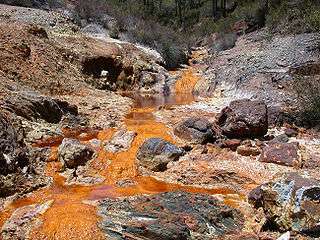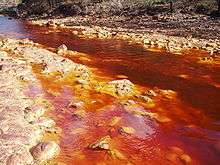Rio Tinto (river)
| Río Tinto | |
| River | |
 Rio Tinto | |
| Country | Spain |
|---|---|
| Region | Andalusia |
| Source | Sierra Morena |
| Mouth | |
| - location | Gulf of Cádiz |
| Length | 100 km (62 mi) |
The Río Tinto (Spanish pronunciation: [ˈri.o ˈtinto], red river) is a river in southwestern Spain that originates in the Sierra Morena mountains of Andalusia. It flows generally south-southwest, reaching the Gulf of Cádiz at Huelva.
Since ancient times, a site along the river has been mined for copper, silver, gold, and other minerals.[1] In approximately 3,000 BC, Iberians and Tartessians began mining the site, followed by the Phoenicians, Greeks, Romans, Visigoths, and Moors. After a period of abandonment, the mines were rediscovered in 1556 and the Spanish government began operating them once again in 1724.[1] As a possible result of the mining, Río Tinto is notable for being very acidic (pH 2) and its deep reddish hue is due to iron dissolved in the water. Acid mine drainage from the mines leads to severe environmental problems due to the heavy metal concentrations in the river. In 1873, Rio Tinto Company was formed to operate the mines; by the end of the 20th century it had become one of the world's largest multinational mining companies, although it no longer controls the Rio Tinto mines; these are now owned by EMED Mining plc.
History

The ore body was deposited in the Carboniferous (300–350 Ma) by hydrothermal activities on the sea floor. The river area has a history of mining activity since the Tartessans and the Iberians started mining in 3000 BC. The mining continued over the Phoenician era and under the Roman Empire until the second part of the 15th century: primarily for copper but also for iron and manganese. In the nineteenth century the mining operation started on a large scale mining companies from the United Kingdom. After the peak of production in 1930, production declined and ended in 1986 for copper mining and in 1996 for silver and gold mining.[2] The mine closed in 2001. Increased copper prices in the 2010s led to efforts by EMED Mining to reopen the mine, but difficulties in acquiring all property rights necessary, environmental concerns, and obtaining regulatory approval delayed reopening. The mine, which employed as many as 20,000 in the past, would employ 350 people during its startup phase. The firm acquired $250 million in financing for the project. Environmental concerns are centered on disused water reservoirs which might not be able to withstand the stress of renewed waste inputs.[3]
Astrobiology
This river has gained recent scientific interest due to the presence of extremophile anaerobic bacteria that dwell in the water.[4] The subsurface rocks on the river bed contain iron and sulfide minerals on which the bacteria feed.[5][6] [7] The extreme conditions in the river may be analogous to other locations in the solar system thought to contain liquid water, such as subterranean Mars. NASA scientists have also directly compared the chemistry of the water in which the rocks of Meridiani Planum were deposited in the past with the Río Tinto.[8] Likewise Jupiter's moon Europa is theorized to contain an acidic ocean of water underneath its ice surface. Thus the river is of interest to astrobiologists.
Based partially on research done near the Río Tinto river, two NASA scientists were reported saying on February 2005 that they had found strong evidence of present life on Mars.[9] NASA officials denied the scientists’ claims shortly after they were released, and one of the scientists, Carol Stoker, said she was misquoted at the party in which the initial statement was made.[10]
See also
References
- 1 2 Bordenstein, Sarah. "Rio Tinto, Spain". Science Education Resource Center. Carleton College. Retrieved March 3, 2009.
- ↑ R.A. Davis Jr.; A. T. Welty; J. Borrego; J. A. Morales; J. G. Pendon; J. G. Ryan (2000). "Rio Tinto estuary (Spain): 5000 years of pollution". Environmental Geology. 39 (10): 1107–1116. doi:10.1007/s002549900096.
- ↑ Raphael Minder (April 12, 2012). "In Struggling Spanish Town, Hopes of Reopening Mine Are Delayed". The New York Times. Retrieved April 13, 2012.
- ↑ Similar extremophile archaea are Archaeal Richmond Mine Acidophilic Nanoorganisms.
- ↑ Fernandez-Remolar DC, Morris RV, Gruener JE, Amils R, Knoll AH (2005). "The Rio Tinto basin, Spain: Mineralogy, sedimentary geobiology, and implications for interpretation of outcrop rocks at Meridiani Planum, Mars". Earth and Planetary Science Letters. 240 (1): 149–167. Bibcode:2005E&PSL.240..149F. doi:10.1016/j.epsl.2005.09.043.
- ↑ Fernandez-Remolar DC, Rodriguez N, Gomez F, Amils R (2003). "Geological record of an acidic environment driven by iron hydrochemistry: The Tinto River system". Journal of Geophysical Research: Planets. 108 (E7): 5080. Bibcode:2003JGRE..108.5080F. doi:10.1029/2002JE001918.
- ↑ Sánchez-Andrea I, Rodriguez N, Amalis R, Sans JL (2011). "Microbial diversity in anaerobic sediments at Rio Tinto, a naturally acidic environment with a high heavy metal content.". Applied and Environmental Microbiology. 77 (17): 6085–6093. doi:10.1128/AEM.00654-11.
- ↑ http://www.jpl.nasa.gov/news/news.cfm?release=2005-167
- ↑ Berger, 2005
- ↑ http://www.nbcnews.com/id/7261407/ns/technology_and_science-space/t/scientist-center-mars-flap-speaks-out/
Further reading
- Berger, Brian (2005). Exclusive: NASA Researchers Claim Evidence of Present Life on Mars. Posted Feb. 16, 2005.
- spacetoday.net (2005). NASA denies Mars life reports. Posted Feb 19, 2005.
External links
| Wikimedia Commons has media related to Tinto River. |
- Mars Analog Research and Technology Experiment FAQ
- (Spanish) Protected Landscape Río Tinto
- (Spanish) With link to the Museo Minero, the fairly new mining museum of the area, containing a permanent exhibition on the history of mining, and geological information.
Coordinates: 37°42′12″N 6°36′10″W / 37.70333°N 6.60278°W